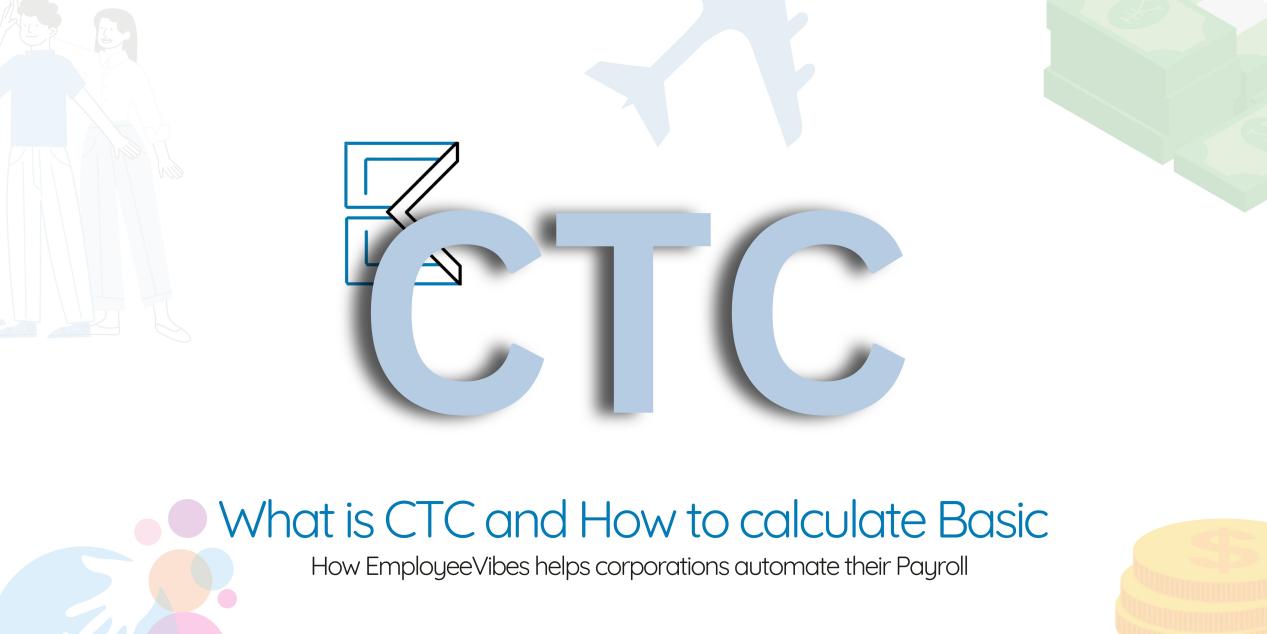What is CTC and How it is Calculated?
CTC, or Cost to Company, is a term commonly used in the context of employment and salary calculations in India. It refers to the total cost incurred by a company in hiring and maintaining an employee, including salary, benefits, and allowances. Understanding how CTC is calculated is crucial for both employers and employees to have a comprehensive view of the overall compensation package.
Components of CTC:
- Basic Salary: Basic salary is the fixed component of the salary structure and forms the foundation for various other calculations. It is usually a percentage of the total CTC and is subject to income tax deductions.
- Dearness Allowance (DA): DA is an allowance paid to employees to mitigate the impact of inflation. It is a variable component that fluctuates periodically based on the cost of living index.
- House Rent Allowance (HRA): HRA is provided to employees to cover their accommodation expenses. The amount of HRA varies based on the city of residence, with higher rates applicable in metropolitan areas compared to non-metro cities.
- Conveyance Allowance: This allowance is granted to cover transportation expenses incurred by employees for commuting to and from work. It is usually a fixed monthly amount.
- Medical Allowance: Medical allowance is provided to employees to cover medical expenses. It can either be a fixed amount or reimbursed based on actual medical bills submitted.
- Leave Travel Allowance (LTA): LTA is granted to employees to cover travel expenses when they take leave. It can be claimed for domestic travel within India and is typically subject to certain conditions and tax exemptions.
- Performance Bonus: Performance bonus is a variable component of CTC and is paid to employees based on their individual or team performance. It is often linked to predefined targets or key performance indicators (KPIs).
- Employee Provident Fund (EPF): EPF is a mandatory contribution by both the employer and the employee towards a retirement savings scheme. The employer contributes a percentage of the employee's basic salary and dearness allowance to the EPF account.
- Gratuity: Gratuity is a statutory benefit provided to employees upon their retirement, resignation, or termination after completing a minimum period of service. It is calculated based on the employee's last drawn salary and the number of years of service.
Calculating CTC:
To calculate the CTC, all the aforementioned components are added together. For example, if an employee has a basic salary of Rs. 500,000, DA of Rs. 50,000, HRA of Rs. 100,000, conveyance allowance of Rs. 10,000, medical allowance of Rs. 20,000, LTA of Rs. 30,000, performance bonus of Rs. 50,000, and the employer's contribution to EPF is Rs. 60,000, the CTC would be:
CTC = Basic Salary + DA + HRA + Conveyance Allowance + Medical Allowance + LTA + Performance Bonus + Employer's EPF Contribution = Rs. 500,000 + Rs. 50,000 + Rs. 100,000 + Rs. 10,000 + Rs. 20,000 + Rs. 30,000 + Rs. 50,000 + Rs. 60,000 = Rs. 820,000 It's important to note that the CTC is a comprehensive figure representing the overall cost to the company for employing an individual. However, the actual take-home salary received by an employee is usually lower due to deductions such as income tax, employee's contribution to EPF, and other applicable deductions.
EmployeeVibes is a comprehensive HR and payroll management software that can greatly assist in the calculation of CTC and streamlining the payroll process for organizations in India. Here are some ways in which Employeevibes can be beneficial:
- Automated CTC Calculation: Employeevibes simplifies the task of CTC calculation by providing a user-friendly interface where HR professionals can input the salary components and their respective values. The software automatically calculates the CTC based on the provided information, reducing the chances of manual errors and saving time.
- Flexible Salary Structures: Employeevibes allows organizations to create customized salary structures tailored to their specific requirements. Employers can define different components, allowances, and deductions, and easily incorporate them into the salary structure. This flexibility ensures accurate CTC calculations that align with the company's compensation policies.
- Integration of Statutory Requirements: Indian payroll involves adherence to various statutory requirements, such as tax deductions, EPF contributions, and gratuity calculations. Employeevibes integrates these statutory regulations into its payroll system, ensuring accurate deductions and calculations as per the applicable laws.
- Tax Compliance: : Calculating income tax deductions for employees can be a complex task due to varying tax slabs, exemptions, and deductions. Employeevibes simplifies the tax calculation process by automatically considering the latest tax rules and generating accurate tax statements and Form 16s for employees. This ensures tax compliance and minimizes the risk of errors or discrepancies.
- Leave and Attendance Management: Leave and attendance management are crucial aspects of payroll processing. Employeevibes provides features for employees to apply for leaves, managers to approve or reject leave requests, and automatic attendance tracking. This data is seamlessly integrated with the payroll system, ensuring accurate leave encashment, deductions, and attendance-based allowances.
- Payroll Processing and Disbursement: Once the CTC calculations are finalized, Employeevibes facilitates streamlined payroll processing. It automates the generation of pay-slips, calculates net salaries after deductions, and provides a comprehensive view of salary disbursements. The software also supports multiple payment methods, such as bank transfers or checks, ensuring hassle-free salary distribution.
- Reports and Analytics: Employeevibes generates detailed reports and analytics related to CTC, payroll, tax deductions, and other relevant aspects. These reports provide valuable insights for management, allowing them to analyze compensation trends, make informed decisions, and ensure compliance with labor laws and regulations.
In conclusion
Employeevibes offers a robust platform for efficient CTC calculation and payroll management. By automating the process, integrating statutory requirements, and providing comprehensive reporting, it simplifies the complex task of managing employee compensation, ensuring accuracy and compliance in payroll processing.



